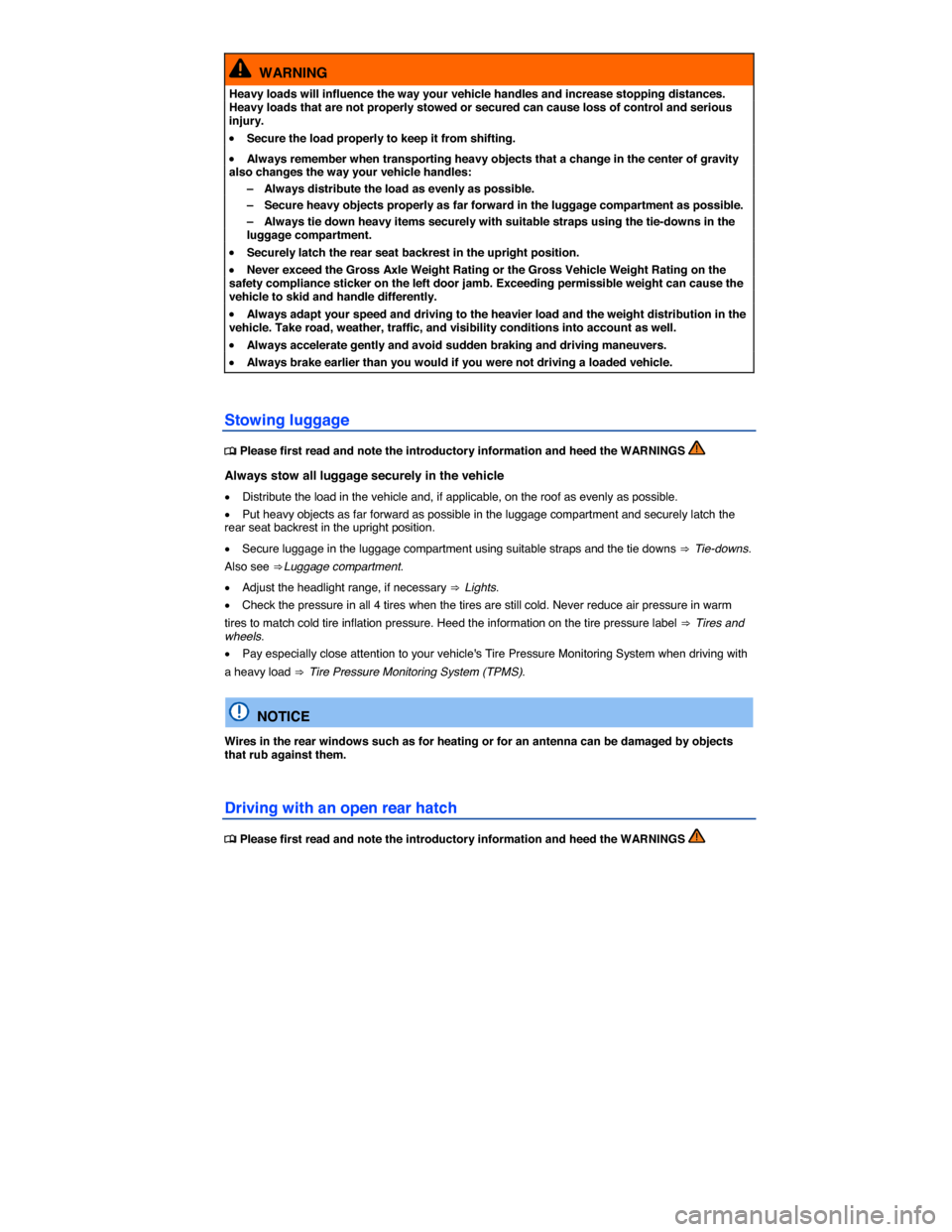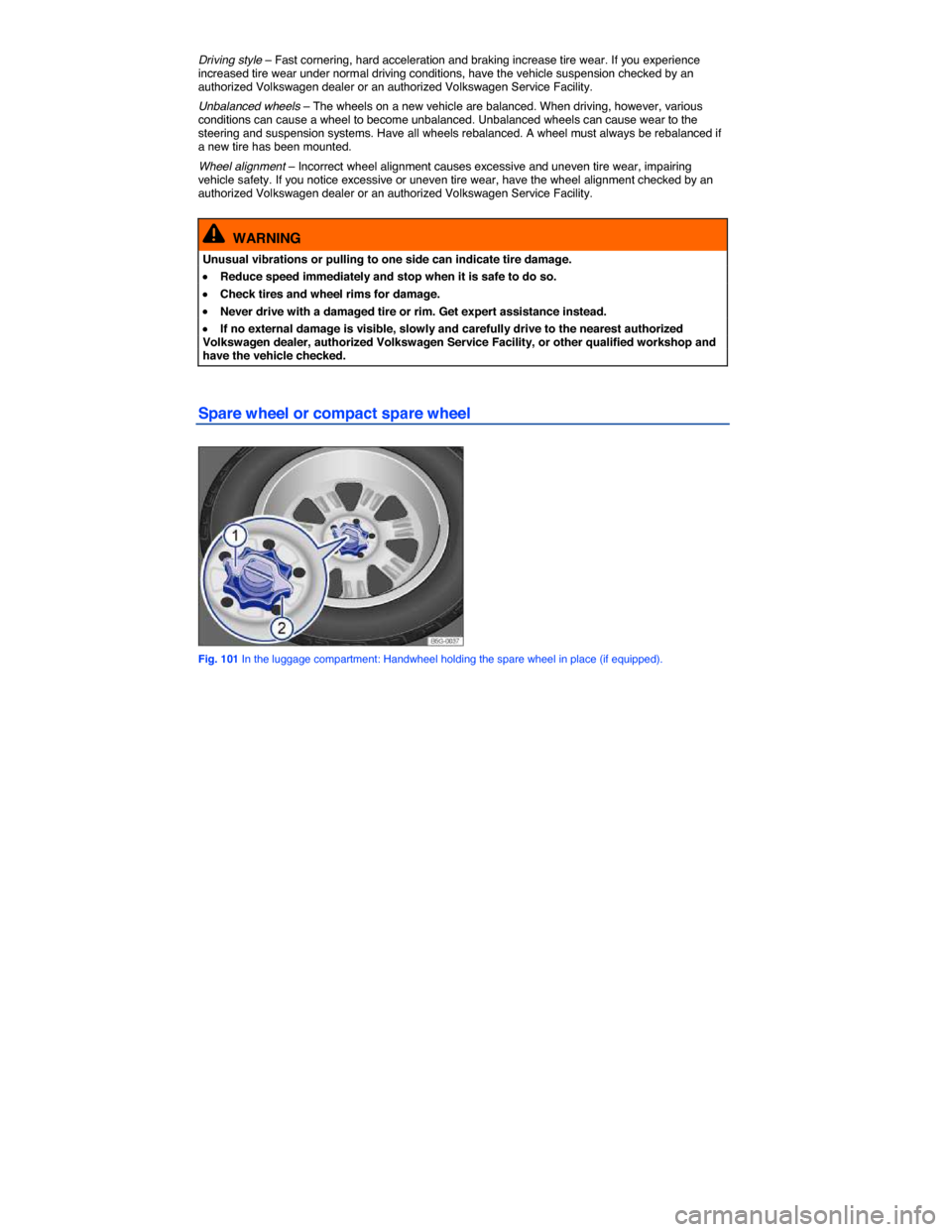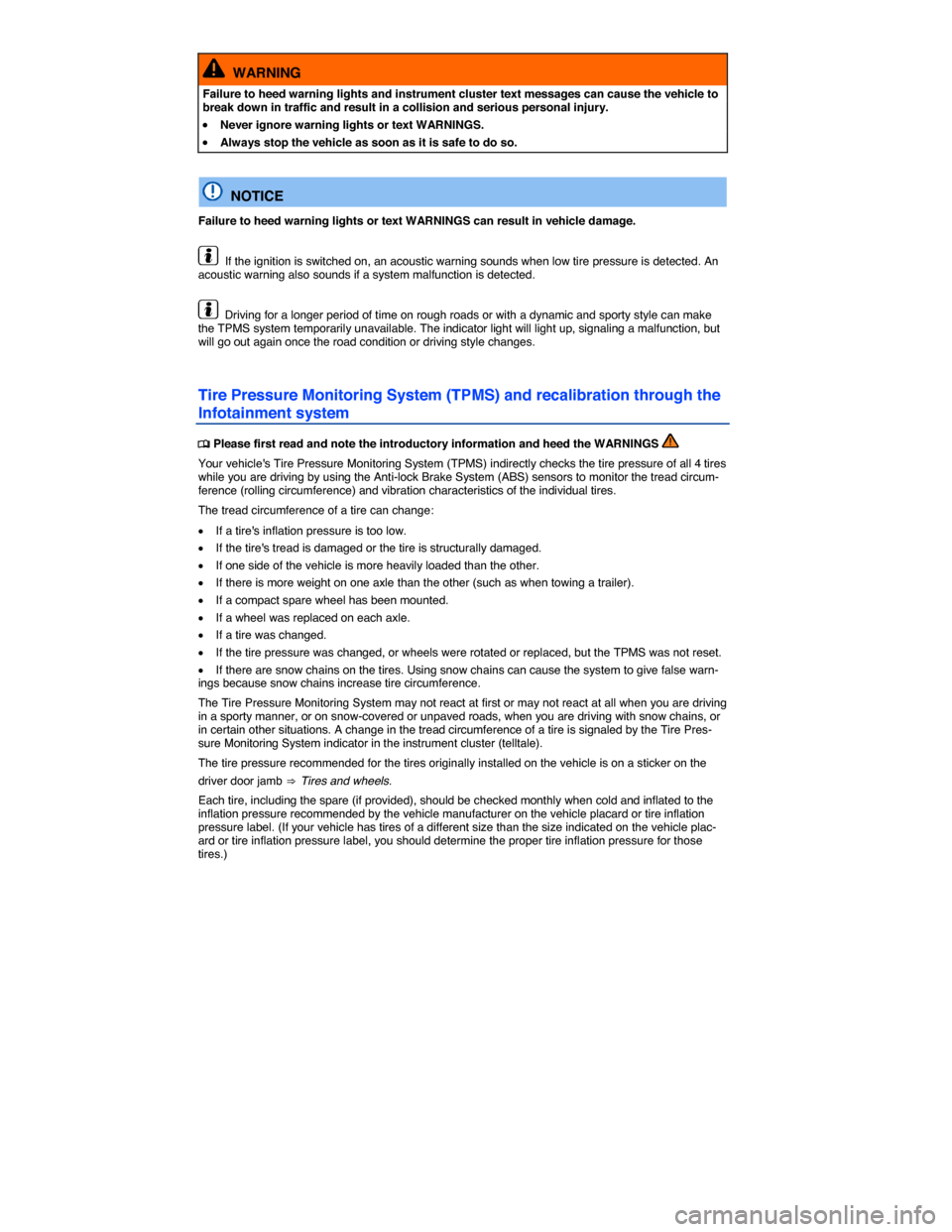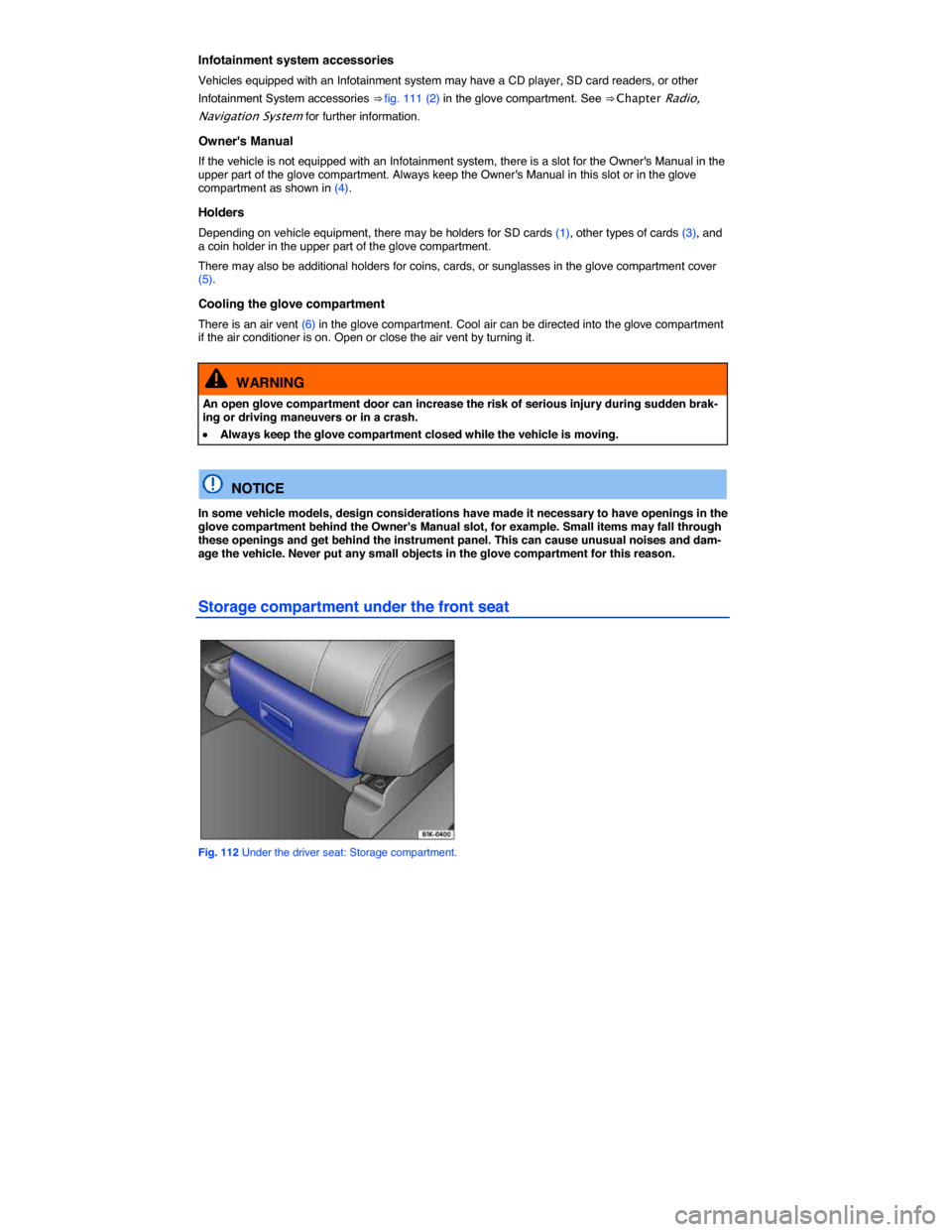2015 VOLKSWAGEN E GOLF Condition
[x] Cancel search: ConditionPage 132 of 394

WARNING
Heavy loads will influence the way your vehicle handles and increase stopping distances. Heavy loads that are not properly stowed or secured can cause loss of control and serious injury.
�x Secure the load properly to keep it from shifting.
�x Always remember when transporting heavy objects that a change in the center of gravity also changes the way your vehicle handles:
– Always distribute the load as evenly as possible.
– Secure heavy objects properly as far forward in the luggage compartment as possible.
– Always tie down heavy items securely with suitable straps using the tie-downs in the luggage compartment.
�x Securely latch the rear seat backrest in the upright position.
�x Never exceed the Gross Axle Weight Rating or the Gross Vehicle Weight Rating on the safety compliance sticker on the left door jamb. Exceeding permissible weight can cause the vehicle to skid and handle differently.
�x Always adapt your speed and driving to the heavier load and the weight distribution in the vehicle. Take road, weather, traffic, and visibility conditions into account as well.
�x Always accelerate gently and avoid sudden braking and driving maneuvers.
�x Always brake earlier than you would if you were not driving a loaded vehicle.
Stowing luggage
�
Page 134 of 394

WARNING
Heavy loads can change the way your vehicle handles and increase stopping distances. Heavy loads that are not properly stowed or secured can shift suddenly, causing loss of con-trol and serious injury.
�x Secure the load properly to keep it from shifting.
�x Always remember when transporting heavy objects that they change the vehicle's center of gravity and also the way it handles.
– Always distribute the load as evenly as possible.
– Secure heavy objects as far forward in the luggage compartment as possible.
– Secure luggage in the luggage compartment using suitable straps and the tie downs ⇒
Tie-downs. Also see ⇒ Luggage compartment.
�x Always tie down heavy items securely with suitable straps.
�x Securely latch the rear seat backrest in the upright position.
�x Never exceed the Gross Axle Weight Rating or the Gross Vehicle Weight Rating on the safety compliance sticker on the left door jamb. Exceeding permissible weight can cause the vehicle to skid and handle differently.
�x Always adapt speed and driving to the heavier load and the weight distribution in the ve-hicle. Take road, weather, traffic, and visibility conditions into account as well.
�x Always accelerate gently and avoid sudden braking and driving maneuvers.
�x Always brake earlier than you would if you were not driving a loaded vehicle.
Weights and axle weights
�
Page 161 of 394

Driving style – Fast cornering, hard acceleration and braking increase tire wear. If you experience increased tire wear under normal driving conditions, have the vehicle suspension checked by an authorized Volkswagen dealer or an authorized Volkswagen Service Facility.
Unbalanced wheels – The wheels on a new vehicle are balanced. When driving, however, various conditions can cause a wheel to become unbalanced. Unbalanced wheels can cause wear to the steering and suspension systems. Have all wheels rebalanced. A wheel must always be rebalanced if a new tire has been mounted.
Wheel alignment – Incorrect wheel alignment causes excessive and uneven tire wear, impairing vehicle safety. If you notice excessive or uneven tire wear, have the wheel alignment checked by an authorized Volkswagen dealer or an authorized Volkswagen Service Facility.
WARNING
Unusual vibrations or pulling to one side can indicate tire damage.
�x Reduce speed immediately and stop when it is safe to do so.
�x Check tires and wheel rims for damage.
�x Never drive with a damaged tire or rim. Get expert assistance instead.
�x If no external damage is visible, slowly and carefully drive to the nearest authorized Volkswagen dealer, authorized Volkswagen Service Facility, or other qualified workshop and have the vehicle checked.
Spare wheel or compact spare wheel
Fig. 101 In the luggage compartment: Handwheel holding the spare wheel in place (if equipped).
Page 166 of 394

Tire labeling (exam-
ple)
Meaning
TWI Marks the position of the treadwear indicator
Made in Germany Country of manufacture.
MAX LOAD 615 KG
(1356 LBS) United States maximum load rating per wheel.
MAX INFLATION
350 KPA (51 PSI)
United States maximum permissible inflation
pressure.
ROTATION Rotation direction (unidirectional tires)
SIDEWALL 1 PLY
RAYON
Tire ply composition and materials used:
1 layer of rayon.
TREAD 4 PLIES
1 RAYON + 2 STEEL +
1 NYLON
Tire tread composition and materials used:
In this example there are 4 layers under the
tread: 1 layer of rayon, 2 layers of steel belt and
1 layer of nylon.
Consumer information regarding comparison to specified base tires
(standardized test procedure) ⇒
TREADWEAR 220 Relative service life expectancy of the tire refer-
enced to a U.S.-specific standard test.
TRACTION A Traction rating under wet conditions (AA, A, B or
C).
TEMPERATURE A Temperature stability of the tire at increased test
bench speeds (A, B or C).
Additional numbers found on the tire could either be tire manufactur-
er internal labels or country-specific labels (such as for Brazil and
China).
Unidirectional tires
Unidirectional tires are designed to rotate only in one direction. Unidirectional tires have arrows on the sidewalls that show the direction of rotation. Make sure you mount the tire so that it rotates in the
Page 171 of 394

Cold tire inflation pressure
The tire pressure recommended by the vehicle manufacturer for a tire of a specified size that has not been driven for more than a couple of miles (kilometers) at low speeds in the 3 hour period before the tire pressure is measured or adjusted.
Curb weight
The weight of a motor vehicle with standard equipment including the maximum capacity of fuel, oil, and coolant, air conditioner, and additional weight of optional equipment.
Extra load tire
A tire designed to operate at higher loads and at higher inflation pressures than the corresponding standard tire.
Gross Axle Weight Rating (GAWR)
The load-carrying capacity of a single axle system, measured where the tire contacts the ground.
Gross Vehicle Weight Rating (GVWR)
The maximum loaded weight of the vehicle.
Groove
The space between 2 adjacent tread ribs.
Load rating (code)
The maximum load that a tire is rated to carry for a given inflation pressure. You may not find this information on all tires because it is not required by law.
Maximum load rating
The load rating for a tire at the maximum permissible inflation pressure for that tire.
Maximum loaded vehicle weight
The total of:
�x Curb weight.
�x Accessory weight.
�x Vehicle capacity weight.
�x Production options weight.
Maximum (permissible) inflation pressure
The maximum cold inflation pressure to which a tire may be inflated. Also called “maximum inflation pressure.”
Normal occupant weight
Means 150 lbs (68 kilograms) times the number of occupants seated in the vehicle up to the total seating capacity of your vehicle.
Occupant distribution
The placement of passengers in a vehicle.
Outer diameter
The diameter of a new, properly inflated tire.
Overall width
Total width measured at the exterior sidewalls of an inflated tire, including the additional width of labeling, decorations, or protective bands or ribs.
Page 183 of 394

WARNING
Failure to heed warning lights and instrument cluster text messages can cause the vehicle to break down in traffic and result in a collision and serious personal injury.
�x Never ignore warning lights or text WARNINGS.
�x Always stop the vehicle as soon as it is safe to do so.
NOTICE
Failure to heed warning lights or text WARNINGS can result in vehicle damage.
If the ignition is switched on, an acoustic warning sounds when low tire pressure is detected. An acoustic warning also sounds if a system malfunction is detected.
Driving for a longer period of time on rough roads or with a dynamic and sporty style can make the TPMS system temporarily unavailable. The indicator light will light up, signaling a malfunction, but will go out again once the road condition or driving style changes.
Tire Pressure Monitoring System (TPMS) and recalibration through the
Infotainment system
�
Page 192 of 394

Infotainment system accessories
Vehicles equipped with an Infotainment system may have a CD player, SD card readers, or other
Infotainment System accessories ⇒ fig. 111 (2) in the glove compartment. See ⇒ Chapter Radio,
Navigation System for further information.
Owner's Manual
If the vehicle is not equipped with an Infotainment system, there is a slot for the Owner's Manual in the upper part of the glove compartment. Always keep the Owner's Manual in this slot or in the glove compartment as shown in (4).
Holders
Depending on vehicle equipment, there may be holders for SD cards (1), other types of cards (3), and a coin holder in the upper part of the glove compartment.
There may also be additional holders for coins, cards, or sunglasses in the glove compartment cover (5).
Cooling the glove compartment
There is an air vent (6) in the glove compartment. Cool air can be directed into the glove compartment if the air conditioner is on. Open or close the air vent by turning it.
WARNING
An open glove compartment door can increase the risk of serious injury during sudden brak-ing or driving maneuvers or in a crash.
�x Always keep the glove compartment closed while the vehicle is moving.
NOTICE
In some vehicle models, design considerations have made it necessary to have openings in the glove compartment behind the Owner's Manual slot, for example. Small items may fall through these openings and get behind the instrument panel. This can cause unusual noises and dam-age the vehicle. Never put any small objects in the glove compartment for this reason.
Storage compartment under the front seat
Fig. 112 Under the driver seat: Storage compartment.
Page 206 of 394

�x The charging port (B)
�x Covers on components of the high-voltage system (B)
Power output of the electric motor
The maximum torque of the electric motor is available as soon as you press the accelerator pedal ⇒
.
As the charge level of the high-voltage battery increases, the recuperation and thus also the electric motor braking effect will decrease when the vehicle is braked and when the vehicle rolls in overrun mode or drives downhill. No brake energy recuperation occurs and therefore no electric motor braking
effect is available once the high-voltage battery is fully charged ⇒ .
DANGER
High-voltage systems in the electric motor compartment and in other places on the vehicle can cause electrical shocks or even electrocution, severe burns, other serious injuries, and even death!
�x Touching damaged orange high-voltage cables, the high-voltage battery or other parts of the high-voltage electrical system can cause fatal electric shock.
�x The high-voltage system may also be active even when the ignition is switched off!
�x Electrolyte fluid in the high-voltage battery will cause severe chemical burns. If electrolyte fluid contacts skin, thoroughly flush affected area with clean water for at least 15 minutes and then wash affected area with soap and water; medical attention is recommended.
�x Any work on the high-voltage system, or on systems which could be directly or indirectly affected by it, must only be carried out by properly trained and qualified experts.
WARNING
Rapid acceleration can cause loss of traction and skidding, particularly on slippery roads. This can cause you to lose control of the vehicle, which can lead to accidents and serious injuries.
�x Always adjust your driving style in accordance with the flow of traffic.
�x Only use the kickdown or fast acceleration if visibility, weather, road and traffic conditions permit, and other road users are not put at risk due to the acceleration and the driving style.
WARNING
Medium, high and very high recuperation can lead to loss of traction and skidding, particular-ly on slippery roads. This can cause you to lose control of the vehicle, which can lead to accidents and serious injuries.
�x Only use medium, high or very high recuperation if visibility, weather, road and traffic conditions permit, and other road users are not put at risk due to the vehicle's acceleration and your driving style.
WARNING
The higher the charge level of the high-voltage battery, the lower the electric motor braking effect, to the point where no electric motor braking effect may be generated at all.
�x Reduce your speed before driving down a long, steep gradient.
�x When driving down a long, steep gradient, slow the vehicle using the vehicle brake.